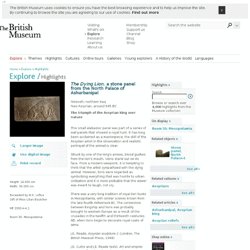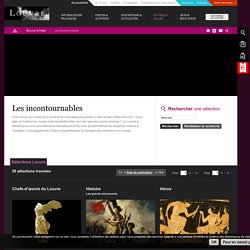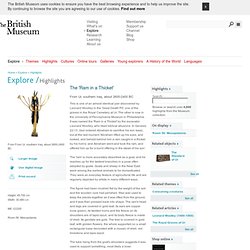

The Dying Lion, a stone panel from the North Palace of Ashurbanipal. Nineveh, northern Iraq Neo-Assyrian, around 645 BC The triumph of the Assyrian king over nature This small alabaster panel was part of a series of wall panels that showed a royal hunt.

It has long been acclaimed as a masterpiece; the skill of the Assyrian artist in the observation and realistic portrayal of the animal is clear. Struck by one of the king's arrows, blood gushes from the lion's mouth. Veins stand out on its face. There was a very long tradition of royal lion hunts in Mesopotamia, with similar scenes known from the late fourth millennium BC. J.E. J.E. Statue de l'intendant Ebih-il – Antiquités orientales. Allez au contenu Allez au menu principal Allez à la recherche Change language Accessibilité Soutenez le Louvre Accueil>Œuvres & Palais>Les incontournables Les incontournables Vous venez au musée du Louvre et ne souhaitez pas passer à côté de ses chefs-d'oeuvre ?

Rechercher une sélection Réinitialiser la recherche Sélections Louvre 29 sélections trouvées Nb par page : 9 - 15 - 30 Tri : Date de publication - Titre Informations pratiques Visites & Activités Expositions & Actualités Œuvres & Palais. Peinture de Til Barsip – Antiquités orientales. Peinture murale – Antiquités orientales. The 'Ram in a Thicket' From Ur, southern Iraq, about 2600-2400 BC This is one of an almost identical pair discovered by Leonard Woolley in the 'Great Death Pit', one of the graves in the Royal Cemetery at Ur.

The other is now in the University of Pennsylvania Museum in Philadelphia. It was named the 'Ram in a Thicket' by the excavator Leonard Woolley, who liked biblical allusions. In Genesis 22:13, God ordered Abraham to sacrifice his son Isaac, but at the last moment 'Abraham lifted up his eyes, and looked, and behold behind him a ram caught in a thicket by his horns: and Abraham went and took the ram, and offered him up for a burnt offering in the stead of his son'.
The 'ram' is more accurately described as a goat, and he reaches up for the tastiest branches in a pose often adopted by goats. The figure had been crushed flat by the weight of the soil and the wooden core had perished. The tube rising from the goat's shoulders suggests it was used to support something, most likely a bowl.
C.L. H.W.F. D. C.L. Queen's Lyre. العربية From Ur, southern Iraq, about 2600-2400 BC Music for the afterlife Leonard Woolley discovered several lyres in the graves in the Royal Cemetery at Ur.

This was one of two that he found in the grave of 'Queen' Pu-abi. Along with the lyre, which stood against the pit wall, were the bodies of ten women with fine jewellery, presumed to be sacrificial victims, and numerous stone and metal vessels. The wooden parts of the lyre had decayed in the soil, but Woolley poured plaster of Paris into the depression left by the vanished wood and so preserved the decoration in place. This musical instrument was originally reconstructed as part of a unique 'harp-lyre', together with a harp from the burial, now also in The British Museum. A similar bull-lyre is depicted on the Standard of Ur. The Standard of Ur › The British Museum. From Ur, southern Iraq, about 2600-2400 BC This object was found in one of the largest graves in the Royal Cemetery at Ur, lying in the corner of a chamber above the right shoulder of a man.

Its original function is not yet understood. Leonard Woolley, the excavator at Ur, imagined that it was carried on a pole as a standard, hence its common name. Another theory suggests that it formed the soundbox of a musical instrument. When found, the original wooden frame for the mosaic of shell, red limestone and lapis lazuli had decayed, and the two main panels had been crushed together by the weight of the soil. The main panels are known as 'War' and 'Peace'. The 'Peace' panel depicts animals, fish and other goods brought in procession to a banquet. Known today as Tell el-Muqayyar, the city of Ur was occupied from around 5,000 BC to 300 BC and was once the capital of an empire stretching across southern Mesopotamia.